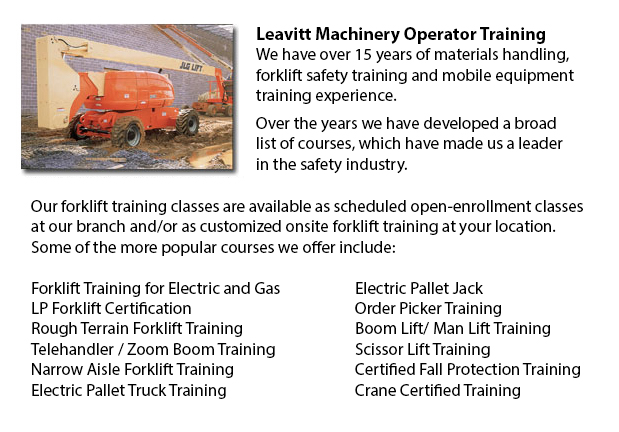
Aerial Lift Safety Training Ottawa - Each and every year, there are around 26 construction deaths attributed to the use of aerial lifts. Nearly all of the craftsmen killed are electrical workers, laborers, carpenters, painters or ironworkers. Most deaths are caused by electrocutions, falls and tip-overs. The greatest danger is from boom-supported lifts, such as cherry pickers and bucket trucks. The majority of the fatalities are connected to this particular type of lift, with the rest involving scissor lifts. Other risks include being thrown out of a bucket, being struck by falling things, and being caught between the lift bucket or guardrail and a thing, like for example a joist or steel beam.
To be able to operate an aerial lift safely, carry out a check on the following things prior to utilizing the device: emergency and operating controls, safety devices (like for instance, outriggers and guardrails), personal fall protection gear, and wheels and tires. Look for possible leaks in the air, fuel-system, hydraulic fluid. Inspect the device for loose or missing parts.
The location where the device will be utilized should be carefully examined for possible dangers, like holes, bumps, debris and drop-offs. Overhead power lines must be closely monitored or avoided. It is recommended that aerial lift devices be used on surfaces that are level and stable. Do not work on steep slopes that exceed slope restrictions that the manufacturer specified. Even on a level slope, brakes, wheel chocks and outriggers must be set.
Businesses should provide their aerial lift operators with the correct guidebooks. Mechanics and operators should be trained by a qualified person experienced with the relevant type of aerial lift.
Aerial Lift Safety Guidelines:
o Before operating, close lift platform chains and doors.
o Do not lean over or climb on guardrails. Stand on the floor of the bucket or platform.
o Make use of the provided manufacturer's load-capacity limits.
o Make use of work-zone warnings, like for example cones and signs, when working near traffic.
If proper procedures are followed, electrocutions are avoidable. Stay at least ten feet away from whatever power lines and qualified electricians should de-energize and/or insulate power lines. People working have to use personal protective equipment and tools, such as insulated bucket. Nonetheless, a bucket that is insulated does not protect from electrocution if, for instance, the person working touches another wire providing a path to the ground.
When in the bucket, workers have to prevent possible falls by securing themselves to the guardrails by utilizing a positioning device or a full-body harness. If there is an anchorage in the bucket, a positioning belt together with a short lanyard is adequate.
Tip-overs are avoidable by following the manufacturer's instructions. Unless the manufacturer specifies otherwise, never drive whilst the lift platform is elevated. Adhere to the device's vertical and horizontal reach limits, and never go beyond the load-capacity that is specified.
-
Telehandler Ticket Ottawa
Telehandler Ticket Ottawa - The telehandler or telescopic handler is a commonly utilized equipment in industrial and agricultural applications. This machine is the same in look to a forklift and also functions in a similar manner, though telehandlers... More -
Telehandler License Ottawa
Telehandler License Ottawa - The telehandler or telescopic handler is a frequently used machine in industrial and agricultural applications. This particular equipment is the same in appearance to a forklift and even functions in a similar way, althou... More -
Forklift Training Courses Ottawa
Forklift Training Courses Ottawa - Our forklift operator safety training has been tailored for illiteracy, thus cutting the training time in half. We provide forklift training certification, lift-truck operator driver safety training evaluation, and... More -
Boom Lift Certification Ottawa
Boom Lift Certification Ottawa - Making use of elevated work platforms allow for work and maintenance operations to be carried out at elevated work heights which were otherwise unreachable. Workers using scissor lifts and boom lifts can be educated i... More -
Aerial Platform Training Ottawa
Aerial Platform Training Ottawa - Aerial lifts might be used to accomplish certain different duties done in hard to reach aerial spaces. Many of the tasks associated with this style of lift include performing routine upkeep on structures with high ce... More -
Loader Operator Certification Ottawa
Loader Operator Certification Ottawa - Ways To Acquire A Loader Operator Certification - Loader Operator Certification is normally needed for personnel working within construction, warehouse or industrial setting to ensure the safe operation of forkl... More -
Aerial Lift / Boom Lift / Man Lift / Scissor Lift Training in Ottawa
Lift tables or also referred to as scissor hoists can raise both individuals and goods vertically. They are normally utilized in commercial, industrial and construction environments. Commonly, the use of a scissor lift truck is to lift and lower thin... More -
Skid Steer Loader Training in Ottawa
The engine powered skid-steer loader comprises a small and rigid frame, equipped together with lift arms which can connect to lots of industrial attachments and tools so as to perform a wide variety of labor saving jobs. Usually, skid-steer loaders a... More

Forklift Training Ottawa
Ottawa, Ontario
forklifttrainingottawa.com
Email Us
About Us


